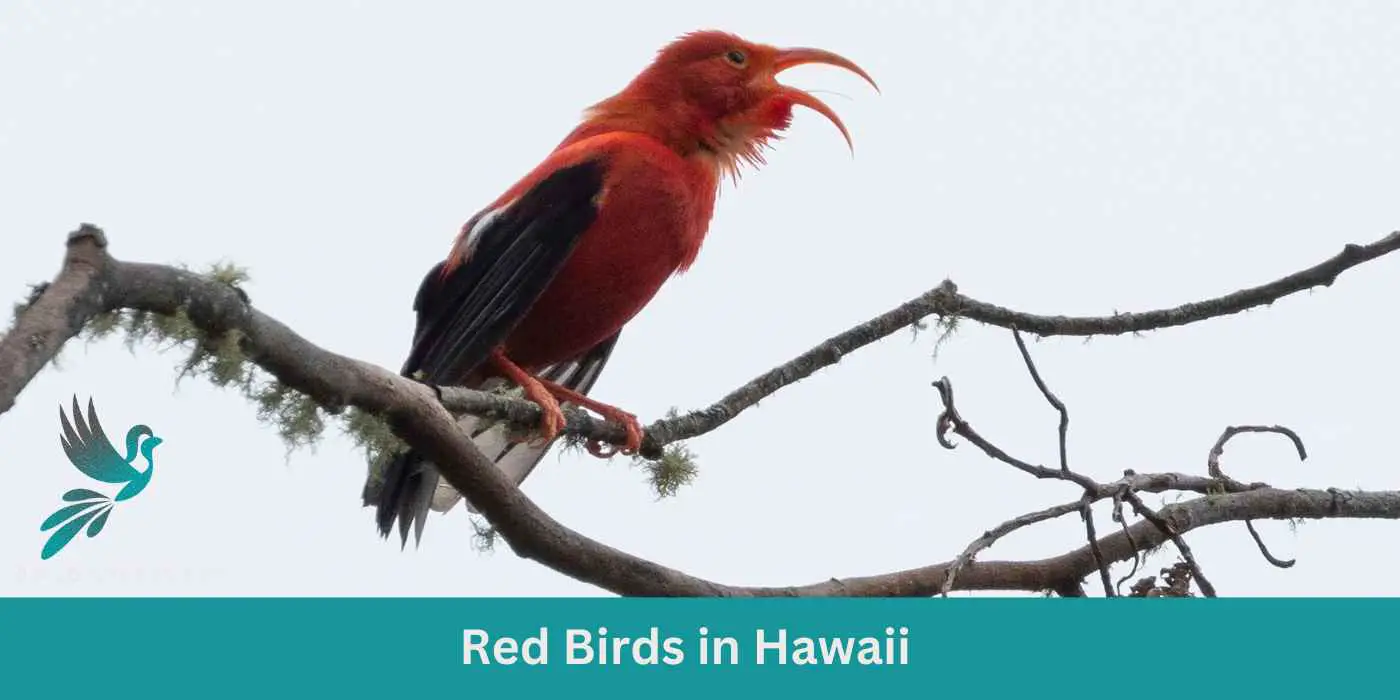Aloha, bird enthusiasts! Beyond its pristine beaches and mesmerizing sunsets, Hawaii harbors a colorful array of avian gems. Dive into this guide and get acquainted with 9 stunning red birds that adorn the Hawaiian skies. Plus, capture their beauty with our complimentary photo guide, ensuring each sighting is a lasting memory. Paradise isn’t just about the beaches—it’s in the skies too!
Red Birds Found In Hawaii
The Hawaiian Islands, located in the center of the Pacific Ocean, act as a crossroads for migratory birds from various regions. Its isolation has also led to the evolution of many endemic species—birds found nowhere else on Earth. Combined with Hawaii’s position along the Pacific Flyway—a major bird migration route—these factors make the state a hotspot for avian diversity, including an array of vibrant red bird species that add a splash of color to the already picturesque landscapes.
Iiwi


| Feature | Measurement |
|---|---|
| Scientific Name | Drepanis coccinea |
| Length | 5.9–6.3 in |
| Wingspan | 8.9–9.1 in |
| Weight | 0.8–0.9 oz |
The Iiwi, also known as the Scarlet Honeycreeper, is an iconic and brightly colored bird native to Hawaii.
Appearance: The Iiwi stands out with its brilliant scarlet plumage, contrasting sharply with its black wings and tail. One of its most distinguishing features is its long, curved, salmon-colored bill.
Diet: As a honeycreeper, the Iiwi primarily feeds on nectar from various native Hawaiian flowers. However, they also consume insects and spiders, especially when feeding their young.
Reproduction: Iiwi build small, cup-shaped nests made from twigs, ferns, and mosses, usually situated in the canopy of ohia-lehua trees. The female lays a clutch of two to three pale blue or white eggs. Both parents take turns feeding the chicks.
Apapane
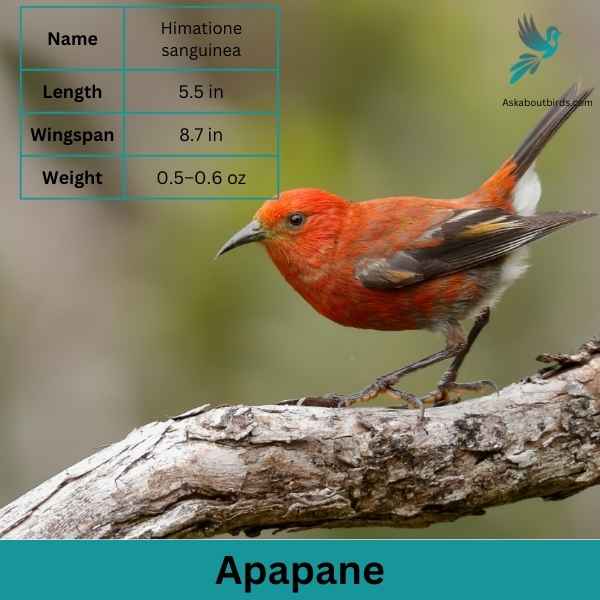

| Feature | Measurement |
|---|---|
| Scientific Name | Himatione sanguinea |
| Length | 5.5 in |
| Wingspan | 8.7 in |
| Weight | 0.5–0.6 oz |
The Apapane is a striking Hawaiian honeycreeper known for its vibrant red plumage and dynamic vocalizations.
Appearance: Predominantly scarlet in color, the Apapane has contrasting black wings and tail. It’s easily identified by its white undertail coverts and slightly curved black bill.
Diet: The Apapane’s diet is primarily nectar-based, with the bird showing a preference for the blossoms of the ohia-lehua tree. Occasionally, they also feed on insects and spiders.
Reproduction: Apapane build their nests in native trees, especially in ohia forests. The nest is a small, neat cup made of mosses, lichens, and small plant fibers. The female typically lays a clutch of two to three eggs, which are pale blue-green in color. Both parents partake in feeding the fledglings.
Hawaii ‘Amakihi
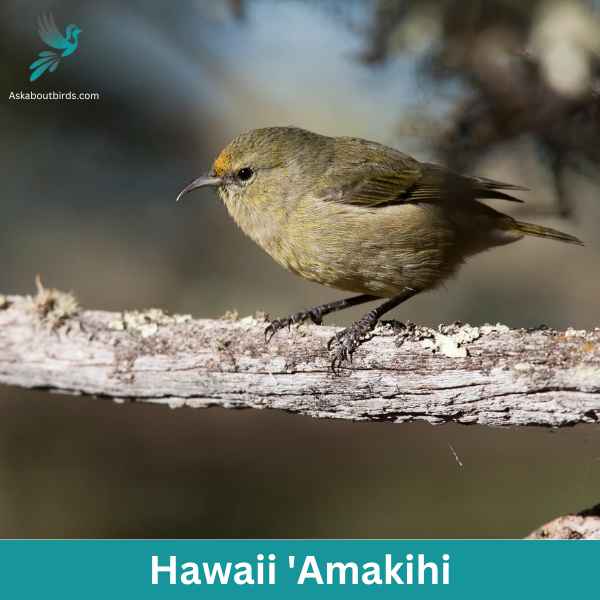

| Feature | Measurement |
|---|---|
| Scientific Name | Chlorodrepanis virens |
| Length | 4.3 inches |
| Wingspan | 7 inches |
| Weight | 0.4-0.5 ounces |
The Hawaii ‘Amakihi is a petite honeycreeper endemic to the Hawaiian islands, showcasing a bright green plumage, reminiscent of the lush landscapes it inhabits.
Appearance: The Hawaii ‘Amakihi boasts a vibrant olive-green hue throughout its body. Its beak is slightly down-curved, making it distinct among Hawaiian birds. The males are a brighter green than the females, but overall, the differences in plumage between genders are minimal.
Diet: The primary diet of the Hawaii ‘Amakihi consists of nectar from native plants, but they are known to be quite adaptive and also consume insects and spiders. They can be observed hovering in mid-air or clinging to the undersides of leaves and branches, hunting for insect prey.
Reproduction: The nesting sites of the Hawaii ‘Amakihi are mostly found in ohia lehua trees. These birds are diligent builders, creating open cup nests using twigs, grasses, and the down of native plants.
Northern Cardinal


| Feature | Measurement |
|---|---|
| Scientific Name | Cardinalis cardinalis |
| Length | 8.3 – 9.1 in |
| Wingspan | 9.8 – 12.2 in |
| Weight | 1.19 – 2.29 oz |
The Northern Cardinal is an iconic North American bird, easily recognized by its vibrant color and melodious song.
Appearance: Male Northern Cardinals are a brilliant scarlet red, while females display a more subdued reddish olive. Both sexes have a distinctive black ‘mask’ on their face around the bill and a pointed crest on their head. The bird’s beak is robust, cone-shaped, and bright orange in color.
Diet: Northern Cardinals are primarily granivorous, with a diet largely consisting of seeds and grains. They also eat fruits and insects. These birds typically feed off the ground and are frequent visitors to bird feeders.
Reproduction: Northern Cardinals are monogamous, and a pair will breed together for life. The female typically builds a well-hidden nest in a dense thicket or shrub. She lays 2-5 eggs per clutch, which she incubates for around two weeks.
Red-Crested Cardinal
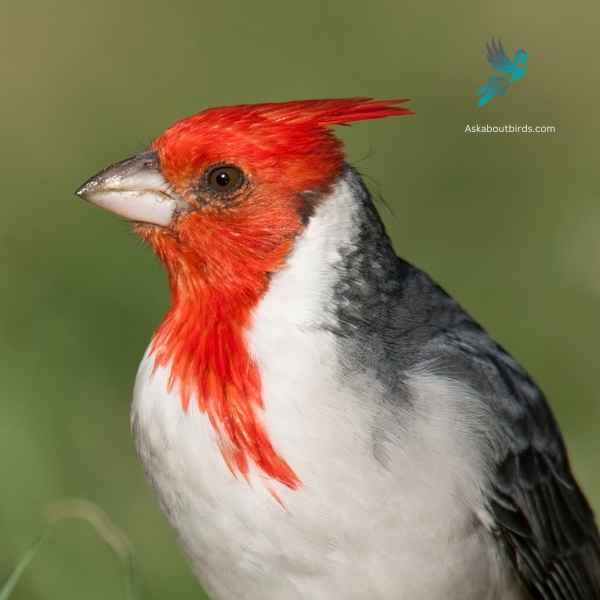
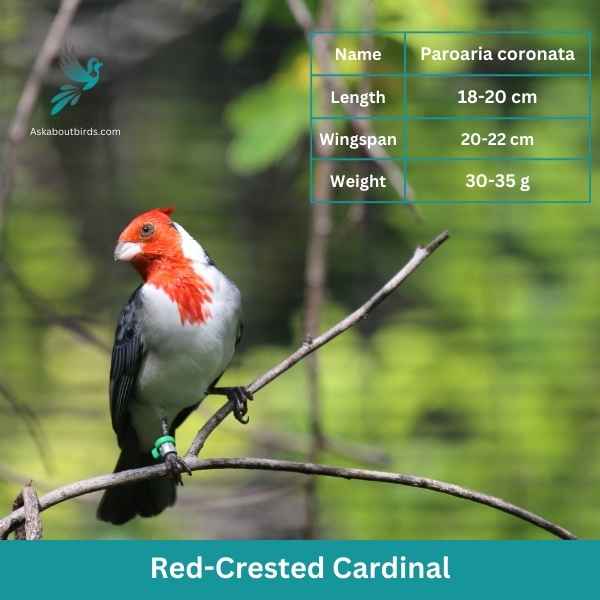
| Feature | Measurement |
|---|---|
| Scientific Name | Paroaria coronata |
| Length | 18-20 cm |
| Wingspan | 20-22 cm |
| Weight | 30-35 g |
The Red-Crested Cardinal is a visually striking bird native to South America, particularly found in countries like Brazil and Argentina. It is named for its vibrant red crest, which stands tall atop its head, contrasting with its grayish body and wings. Both males and females share this distinctive feature, with males having more pronounced red coloration.
These cardinals are typically found in open habitats such as grasslands, savannas, and gardens. They have adapted well to human-altered landscapes. Red-Crested Cardinals are omnivorous, feeding on a diverse diet that includes seeds, fruits, insects, and even small vertebrates. They use their powerful beaks to crack open seeds and capture prey.
Red Avadavat


| Scientific Name | Length | Wingspan | Weight |
|---|---|---|---|
| Amandava amandava | 3.9-4.3 inches | 4.5-5 inches | 0.3-0.4 ounces |
The Red Avadavat, often referred to as the Strawberry Finch or Red Munia, is a small, vivacious songbird renowned for its vibrant colors and melodious tunes.
Appearance: Males, especially during breeding season, are adorned in a striking bright red plumage punctuated with white spots, rendering them highly conspicuous. They also possess a distinct red bill. Outside the breeding period, their plumage dulls to a brownish hue. Females and juveniles, on the other hand, consistently exhibit a more muted, brownish appearance throughout the year, devoid of the red brilliance.
Diet: These tiny birds predominantly thrive on seeds. Their favorite picks include grass seeds, and occasionally, they partake in small insects, which offer them essential proteins.
Reproduction: Red Avadavats are ground nesters, crafting their nests amid grassy terrain using grass and other available materials. The nests, spherical with a side entrance, provide a cozy environment for their eggs. A typical clutch encompasses 4 to 6 white or pale blue eggs.
Red-masked Parakeet

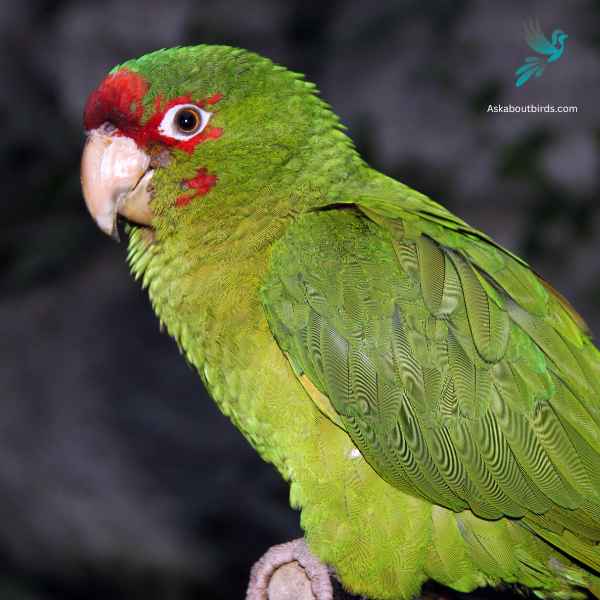
| Feature | Measurement |
|---|---|
| Scientific Name | Psittacara erythrogenys |
| Length | 13 inches |
| Wingspan | 17 inches |
| Weight | 5.6-6.3 ounces |
The Red-masked Parakeet is a vibrant and lively bird, often recognized for its distinctive coloration and spirited nature.
Appearance: This parakeet is predominantly green, with the most distinguishing feature being its bright red face mask and frontal area, giving it its common name. The eye region is usually white, and they also display red wing coverts which contrast vividly with the main green body color.
Diet: Red-masked Parakeets are omnivorous. They feed primarily on a range of fruits, nuts, seeds, and berries. In some urban settings, they’ve been observed enjoying various human foods, but they thrive best on natural plant material.
Reproduction: These parakeets nest in tree cavities. After a courtship period consisting of feeding and mutual preening, the female typically lays a clutch of 3 to 4 white eggs. Once hatched, the chicks are cared for by both parents until they are ready to fledge, which usually takes just over a month.
Yellow-billed Cardinal

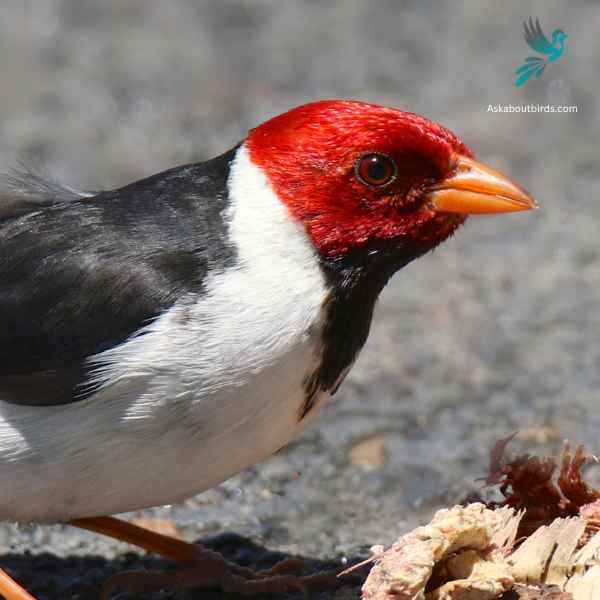
| Feature | Measurement |
|---|---|
| Scientific Name | Paroaria capitata |
| Length | 6.7 inches |
| Wingspan | 10 inches |
| Weight | 0.8-1.2 ounces |
The Yellow-billed Cardinal is a vibrant songbird that grabs attention with its stark color contrast and melodic chirping.
Appearance: The Yellow-billed Cardinal, as the name suggests, possesses a striking yellow bill. The male has a vivid red head and chest that contrasts with its white underparts and black upperparts. The female, although similar, is slightly paler in color. Both sexes have conspicuous white patches on the flanks.
Diet: These cardinals primarily feed on seeds, fruits, and insects. They have a preference for seeds from grasses and small aquatic plants. They can also be seen foraging on the ground or near the water’s edge for insects and other small invertebrates.
Reproduction: Yellow-billed Cardinals are monogamous and form strong pair bonds. They construct cup-shaped nests in dense vegetation or shrubs, often near water. After mating, the female typically lays a clutch of 2 to 3 eggs. Both parents participate in incubation, which lasts about 12-13 days. Post hatching, both the male and female are involved in feeding and nurturing the chicks until they fledge in about 18 days.
House Finch


| Feature | Measurement |
|---|---|
| Scientific Name | Haemorhous mexicanus |
| Length | 5–6 in |
| Wingspan | 8–10 in |
| Weight | 0.6–0.9 oz |
The House Finch is a small songbird widely distributed across North America and is commonly found in urban and suburban areas.
Appearance: Males of this species are brightly colored with crimson faces and throats, which can extend to the chest and back, while their flanks have streaks. The female is streaked brown and lacks the red coloring. Both have a square-tipped tail and a distinctively long, flat-topped bill.
Diet: House Finches primarily eat seeds, grains, and berries. They have a particular fondness for sunflower seeds and can be commonly seen at bird feeders. Occasionally, they will also consume insects, especially during the breeding season.
Reproduction: House Finches are cavity-nesters and might choose ledges, vents, ledges, and other urban settings. They might also utilize trees or shrubs. Their nests can be made of a wide array of materials, from feathers to twigs.
Where to Spot Hawaii’s Red Birds
Hawaii, with its diverse habitats and remote location, is a birdwatcher’s paradise, boasting endemic species seen nowhere else on Earth. Here are some of the most renowned spots in Hawaii to witness the incredible avian diversity, especially the stunning red birds:
- Hakalau Forest National Wildlife Refuge, Big Island: Located on the windward slope of Mauna Kea, this refuge is home to numerous native birds, including the Hawaii ‘Amakihi and the rare ‘Akiapola’au. The pristine native forests provide an unmatched birdwatching experience.
- Kīlauea Point National Wildlife Refuge, Kauai: A coastal sanctuary, this refuge attracts a variety of seabirds and is a fantastic place to spot the Red-tailed Tropicbird. Its dramatic cliffs and panoramic ocean views add to the birdwatching allure.
- Kealia Pond National Wildlife Refuge, Maui: This coastal wetland is a magnet for migratory waterfowl and wading birds. Apart from the regular sightings, during certain seasons, one can spot the striking Hawaiian Coot with its prominent white frontal shield.
- Waimea Valley, Oahu: A botanical garden and a haven for several bird species, this lush and culturally-rich valley is a peaceful spot for birdwatching. The vibrant red ‘I’iwi, a Hawaiian honeycreeper, is often spotted flitting between the native trees.
- Hosmer Grove, Haleakalā National Park, Maui: Located in the cloud belt of Haleakalā, this grove is a great location to spot forest birds early in the morning, including the ‘Apapane which is known for its brilliant red plumage and melodious song.
Hawaii is an isolated archipelago in the central Pacific and doesn’t have any neighboring states in the traditional sense. However, if we consider the closest U.S. state to Hawaii, it’s California.
| California’s Red Birds | Best Spots for Red Birds |
|---|---|
| Point Reyes National Seashore, Northern California | Renowned for its diverse habitats and migrant bird populations. |
| San Joaquin Wildlife Sanctuary, Irvine | A serene haven hosting numerous species throughout the year. |
| Tule Lake National Wildlife Refuge, Northern California | A major hub for migratory birds, especially waterfowls. |
FAQs on Red Bird Species Found in Hawaii
What red-headed birds were introduced to Hawaii and have now become a common sight?
The Brazilian Cardinal, also known as the Hawaiian Cardinal, is one of the introduced bird species in Hawaii. With its striking plumage featuring a bright red head and gray body, this bird has become well-established across the main islands. Although it’s called a cardinal, it’s important to note that it’s not closely related to the true cardinal family from the Eastern United States.
Yes, the introduction of non-native species, like the Brazilian Cardinal, to Hawaii has raised ecological concerns. Introduced species can sometimes become invasive, competing with native Hawaiian birds for resources and potentially disrupting the local ecosystem. While the Brazilian Cardinal has adapted well to human habitation and urban areas, its impact on native species and habitats is continually monitored.
Can Hawaiians attract the Brazilian Cardinal to their backyards?
Absolutely! The Brazilian Cardinal, with its bright red crest and distinctive appearance, is often drawn to bird feeders in urban areas. By providing a mix of fruit flies and small fish, residents can attract these beautiful birds and observe their behaviors up close. However, it’s essential to ensure that the feeding doesn’t favor the introduced species over the native Hawaiian bird population.
Are there other red birds in Hawaii with a similar history as the Brazilian Cardinal?
Yes, the Red Junglefowl is another bird with a bright red plumage that was introduced to Hawaii. It’s believed to be the ancestor of the domesticated chicken. While the Red Junglefowl has a long history in Hawaii, it, like the Brazilian Cardinal, is not native to the islands. Both these birds are examples of how human actions can introduce different species to new environments, leading to unforeseen ecological implications.

